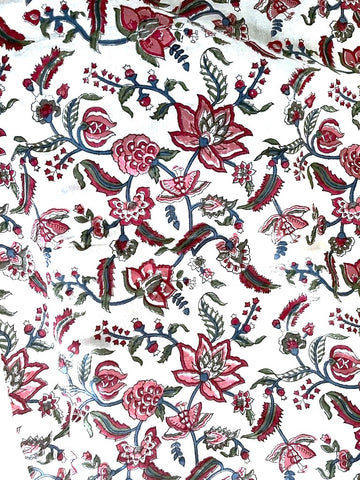Free standard domestic shipping from Queensland across Australia. 30-day returns.
For delivery to the USA and Canada, click here
Free standard domestic shipping from Queensland across Australia. 30-day returns.
For delivery to the USA and Canada, click here
CHINTZ – A Historic Textile
September 02, 2023 3 min read
Indian chintz needs no introduction, yet not everyone appreciates the long history of this colourful hand painted or wood blocked glazed cotton fabric, crafted by Indian artisans for centuries.
In very simple terms, the meaning of chintz is typically an applied technique of repeat florals and motif design patterns, on bleached cotton fabric using mordants and resists to help the dye adhere. The bleaching became a process to keep the colours vibrant and the term ‘chintz’ originated from India, and derived from the Hindi word ‘chint’, meaning spotted.

Green Chintz tablecloth
Introduction to Chintz :
Chintz was introduced to Europeans as far back as the 15 th century (predominately by Portuguese and Dutch traders) when they set out on their search for spices. This textile made its way to Europe by the mid 16 th Century and sparked vast interest and eventually became a highly sought-after textile throughout the world, including the Americas.
“The painting of ‘chints’ proceeds in a most leisurely manner, similar to the crawling of snails which appear to make no headway. Anyone who would represent patience…could use the painters of Palicol as a model.”
Daniel Havart, 1693.

Jacket and Shawl in Chintz, Skirt in glazed chintz, 1770-1800, Fashion Museum Province of Antwerp
It was banned for some time in parts of Europe due to the detrimental threat to the local linen, wool, and silk mills and to help protect businesses, however, it still managed to sneak its way in, as it was extremely popular with the ‘upper classes’ in Britain, France and the Netherlands.
By the 18th century the design was widely used for clothing, upholstery, bedspreads, curtains, soft furnishings, and wall hangings. Chintz began captivating the world. It became increasingly in demand with fashion textile homes by the 19 th century.

Chintz Bed Hanging, 1603
An Undeniable Quality
Further, by the 19th century the finished product of ‘Chintz’ was proving to be very expensive due to the long process involved. Imitation chintz was eventually
industrialized to make way for an economical and faster alternative to the traditional methods, and to meet with high demand.
Despite the quality of the new variation comparing relatively well, making it now affordable for ‘all the classes’, the chintz exported from India remained the preferred choice due to its beautiful texture and organic elements, which Europeans were not quite up to speed in adopting.
When we think of chintz in Western society, we think of how furniture, wallpaper,
homewares, table linens and clothing were adorned with this intricate design and even now in the 21st century its popularity continues. This style of print (for some) may have been exhausted throughout interior design over the centuries, but it will undoubtedly continue to make its presence felt (as it deserves) well into the next. You could say chintz has had a recent rival thanks to ‘mid-century modern’, which means you are basically mixing vintage design with new pieces.

Chintz Fragment, India, 1750-1800
Despite this, it was quoted in the 1990s “chintz prints were classified as dead” for some and considered ‘over exposed’ in the 1980’s by design houses like Laura Ashley for instance, who always had a place for chintz.
How To Decorate Your Home with Chintz
Chintz has always been a light-medium weighted textile, and suitable for soft
furnishings like table linens. There is nothing more beautiful than an original
handblocked Indian tablecloth or napkins to display your homewares on when you are practising your culinary talents.


At Décor Mantra we have an exclusive range of original Indian handblocked Chintz tablecloths.
Conclusion
You are not wrong in thinking chintz has had current and past trends, especially with floral patterns coming in and out of style for hundreds of years, as we know it.
Today you can decorate with chintz in interior design to replicate the past and it will not look out of place. Team your chintz homewares and soft furnishings with basic neutral bases and watch your space come to life with bold patterns and vibrant colours.
Credits:
Homes and Antiques
Fashion & Textile Museum
Myrtle at Atelier Nostalgia
Leave a comment
Comments will be approved before showing up.

